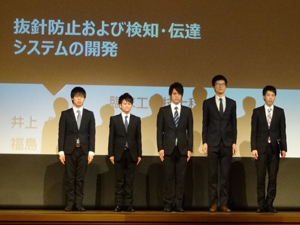Osaka College of High Technology Graduation Research Project Symposium
Osaka College of High Technology held its Graduation Research Project Symposium for the 2014/2015 Academic Year at the Osaka Central Public Hall on Friday, January 30. Graduation research at the college began in 1987, the year it first began offering classes. Since then students at the school have conducted more than 2,700 research projects. Osaka College of High Technology has continued to focus on professional education as a part of specialized education and career education for twenty-eight years and in doing so has become one the roots of graduation research education at the Jikei Group of Colleges.
The Osaka Central Public Hall has been designated an important cultural property by the government of Japan, and students delivered presentations in an environment steeped in culture and tradition. The program for the symposium listed twenty-nine presentations in the General Presentation Group in the morning and seven presentations in the Honors Presentation Group in the afternoon for a total of thirty-six presentations.
In the Honors Presentation Group, a student from the Clinical Engineer Department was awarded top marks for his presentation entitled “Preventing Needle Dislodgement and Developing a Detection and Transmission System.” Needle dislodgements currently account for the highest number of accidents in hemodialysis at 25.3%. In their presentation, students announced that they had developed a system that detects blood leakage resulting from needle dislodgement and then transmits that information wirelessly to medical staff. They expressed their hope that it would reduce the risks associated with hemodialysis. People with ties to hospitals were in the auditorium on the day of the presentation.
Students from the Robotics Sciences Department undertook the development of a plan along with the system and sensors for introducing dual-arm robots on factory lines for producing metal containers as a corporate project entitled “Verification of Dual-Arm Robots Introduced on automated factory lines.” The students delivered a richly creative presentation, not only on the assignment received from the corporation but also on their ideas for the design of a robot which could adapt to its environment.
Presentations were also given by students from other departments including the Clinical Engineer Department, “Trial for a Multipurpose Sensor for High-Flow Nasal Oxygen Administration,” the Bioscience Department, “Developing an Inhibitory Immune Cell Control Method for the Next Generation of Cancer Immunotherapies,” the Sports Medicine Department, “Effects of Hypoxic Training on the Body,” and the Judo Therapy Sports Medicine Department, “Changes in Lactic Acid Levels Resulting from Citric Acid Intake and Aerobic Exercise.”
And finally, as a special presentation, students from the Japanese Language Department gave a presentation entitled “Achieving Success on the Clinical Engineering Technician National Examination for International Students from China.” The presentation cast light on the academic difficulties Chinese students experience studying in Japan to acquire medical-related Japanese national qualifications as well as future issues.
For example, katakana, which is used in written Japanese, poses a particularly vexing problem for Chinese students in Japan. This is because each character in Chinese has a meaning, and they understand the meaning when they see a word. But with katakana, they cannot understand the meaning. For katakana words not found in a standard dictionary, students study by first translating the word into English and then translating it into Chinese using an English-Chinese dictionary.
The presentation was sympathetic to the difficulties faced by Chinese students. Questions such as “How can students overcome challenges such as these in the future?” or “How should we convey information to younger students?” have become issues for Japanese language educators
Fumoto Ryogane, Director of Fuji Sankei Business in Osaka, commenting on the presentations said “Many of the research presentations this year could be adopted immediately to prevent accidents in the medical workplace. I would certainly like to see these considered for implementation.” Mr. Ryogane also gave us the keywords “Continuity and Growth” as future topics for the following year’s presentations.
And finally, Mr. Makoto Hatano, a second year student from the Judo Therapy and Sports Medicine Department, gave an impressive closing address. Speaking on behalf of the students, Mr. Hatano said “We have been able to overcome many obstacles in conducting research—the difficulties of performing experiments, the importance of planning, the significance of cooperating with others, the challenges of presenting in an easy-to-understand manner—we have been able to overcome all of these and to grow.”
The Graduation Research Project Symposium is the culmination of professional education at Osaka College of High Technology. Research has enabled students to cultivate the ability to develop many different skills on their own, such as problem discovery skills, creativity, planning skills, implementation skills, and communication skills. Mr. Hatano’s closing address on behalf of his fellow students is emblematic of students’ understanding of the significance of graduation research as well as evidence of their growth.
Osaka College of High Technology will look to further improvements in graduation research and research projects as a means of taking a sure step forward in the training of professionals.

